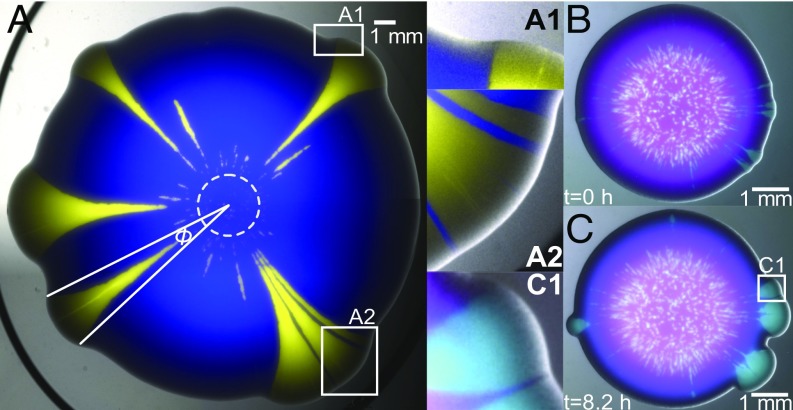Fig. 1.
S. cerevisiae colony-growth experiments hint at physical interactions between strains. (A) Combined fluorescent and bright-field image of a colony, 4 d after the inoculation of a mixed droplet of strains yAG1 (blue) and yAG2 (yellow) at relative frequencies of 99% and 1%, grown at 30 °C. The white dashed circle marks the inoculum size. Because yAG2 divides faster at 30 °C, some single-strain yellow sectors expand their opening angle as the colony grows radially, while others go extinct due to stochastic effects in the early stages of growth. By expanding faster, the faster-growing strain displaces the other strain at both sides of yellow sectors (A1) and can enhance the expansion speed of the slower-growing strain when it is trapped between two yellow sectors (blue filaments in A2) and is carried along. (B and C) Even nonproliferating cells (magenta) can be pulled outward by a proliferating (cyan) strain. The images show combined fluorescent and bright-field images of the same colony at early and later times. In this experiment, the non–heat-sensitive strain yAG19 (cyan, initial frequency 10%) and the heat-sensitive strain yAG20 (magenta, initial frequency 90%) were grown at 28 °C for 2 d and subsequently imaged with a stereoscope incubated at 37 °C, a temperature at which yAG20 cells cannot divide. B shows the first snapshot at which the heat-sensitive strain stopped expanding (SI Appendix, Fig. S1D). C shows the colony after a further 8.2 h. (C1) Close-up of the region marked with a white square in C, highlighting the displacement of the nongrowing, heat-sensitive strain next to expanding sectors of the growing strain and an expanding magenta filament trapped between two cyan sectors. Because the heat-sensitive strain did not divide between B and C, its displacement is due to the physical interaction between the two strains.

